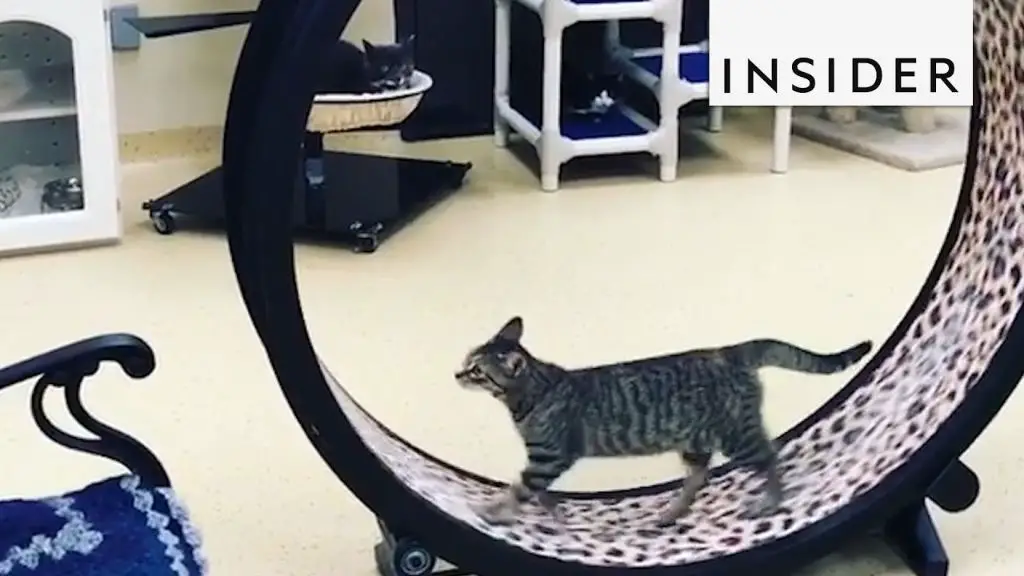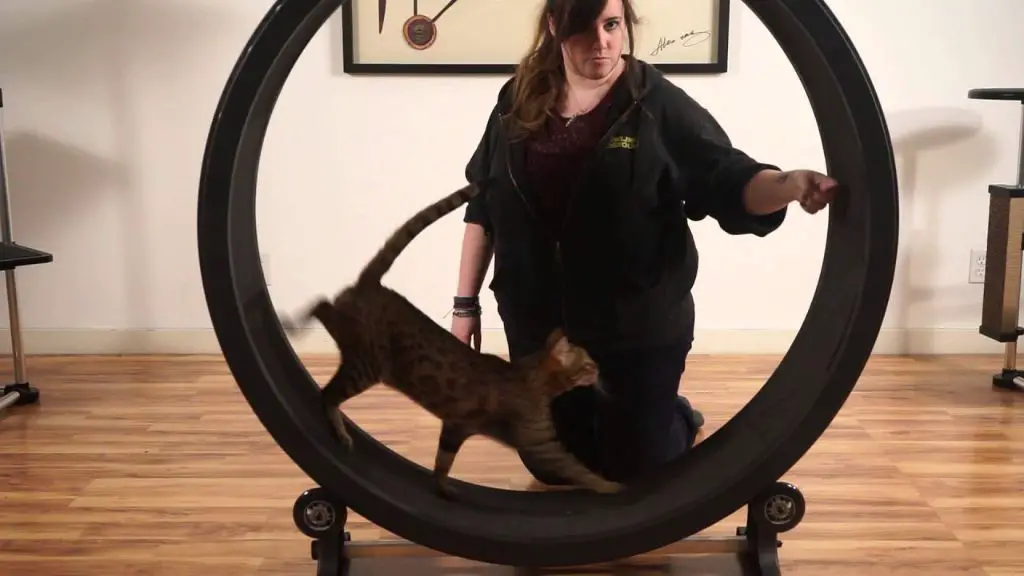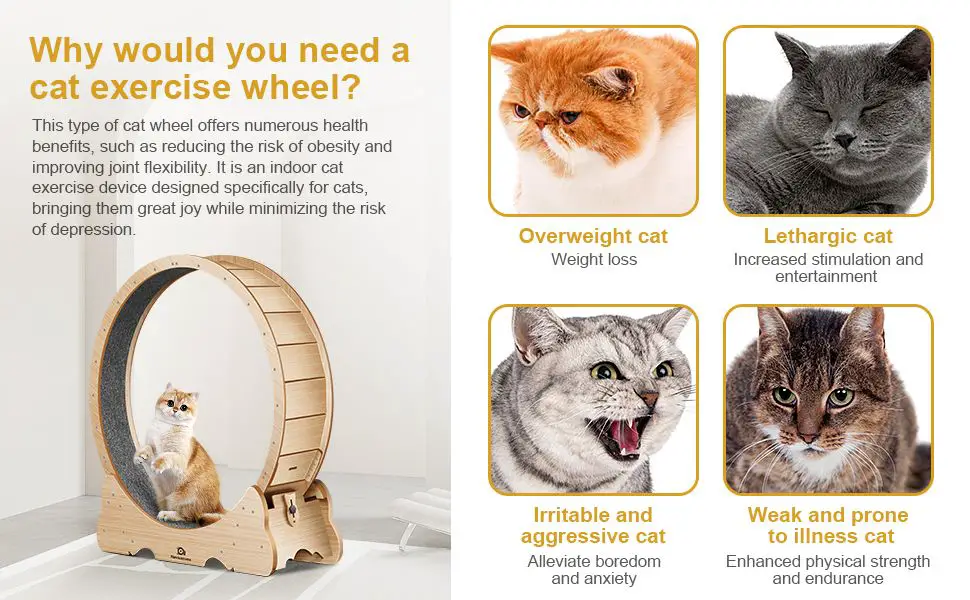What Are Cat Wheels?
Cat wheels are large exercise wheels designed specifically for cats. They typically consist of a circular wheel mounted on a stand with a running surface made of plastic, nylon, or cardboard. The wheel allows cats to walk, jog, or run in place while remaining safely enclosed inside the wheel.
Cat exercise wheels provide cats with an outlet for their natural instinct to hunt, run, and play. They allow cats to get physical and mental stimulation without leaving home. The wheels range in size from about 3 feet in diameter for a single cat up to 5 feet for multiple cats. The running surface is usually wide enough for a cat to turn around comfortably.

Cat wheels operate similarly to hamster exercise wheels, but are sized appropriately for cats. They have safety features to prevent injury such as no pinch points and a curved track to keep cats centered while exercising. Most cat wheels have a freestanding base so they can be used indoors without attachment to the wall or ceiling.
Overall, cat wheels offer feline companions an engaging and enriching way to exercise their mind and body within the comfort of home. They satisfy a cat’s basic need for daily activity.
Benefits of Cat Wheels
Using a cat wheel can provide numerous health and wellness benefits for cats. According to Fear Free, exercise wheels help cats stay active, supporting both their physical and mental health. The wheels give cats an outlet to burn off excess energy and prevent boredom or frustration from being cooped up indoors.
Regular use of a cat wheel can improve cardiovascular health, muscle tone, digestion, and sleep quality. The aerobic exercise tires cats out in a positive way, leading to better behavior and less stress. Kitties who get daily activity on a wheel are often calmer and more relaxed. Exercise also releases endorphins that lift a cat’s mood.
In addition to physical exercise, cat wheels provide mental stimulation. Running on the wheel gives cats an engaging activity to focus their natural hunting instincts on. The changing scenery and ability to control the wheel’s motion can be intellectually stimulating. This mental enrichment wards off boredom and inappropriate behavior like shredding furniture.
Considerations Before Buying
There are a few key things to consider before investing in a cat wheel to ensure it’s the right choice for you and your cat. First, be sure you have adequate space for the wheel. Cat wheels range in diameter from about 3 feet up to 5 feet across. Make sure you have enough open floor space to accommodate the wheel you select. According to Rover, you’ll want at least 4-6 feet of clearance around the wheel for your cat to comfortably use it without bumping into walls or furniture.

Also consider your cat’s personality and exercise habits. Some cats may not take to a wheel, while others will embrace it immediately. Know if your cat enjoys climbing, running, and engaging with new toys. An active cat who loves to play will be the best candidate. Consider starting with a less expensive DIY or basic model to test it out before investing in a premium wheel.
Safety is paramount. Look for solid construction with enclosed sides to prevent injuries. Wheels and hinges should be sturdy and escape-proof. Choose non-toxic, durable materials. Ensure the wheel has no pinch points. Start slowly, supervising your cat’s first uses until you’re confident in their safety. With caution and proper use, a wheel can provide cats great exercise and enrichment.
Top Recommended Cat Wheels
Based on expert reviews and customer ratings, here are some of the top cat wheels to consider:
One Fast Cat Wheel
The One Fast Cat wheel is one of the most popular and highest rated cat exercise wheels. It has a durable but lightweight frame and a large, smooth running surface that can accommodate cats up to 40 lbs. The wheel has a limited lifetime warranty and many owners say their cats took to it right away. The One Fast Cat wheel is on the pricier side but often earns rave reviews.
Pawsome Cat Wheel
The Pawsome wheel is a more budget-friendly option that still provides a safe and sturdy workout for cats. It has a plastic running surface and metal frame. The Pawsome cat wheel comes in different sizes to accommodate everything from kittens to larger cats. Many owners say it was easy to assemble and their cats enjoyed using it.
GoCat Exercise Wheel
The GoCat is a metal-framed wheel with a carpeted running surface for traction. The carpet is durable and easy to remove for cleaning. This wheel can support cats up to 44 lbs. It comes in fun color options and is relatively affordable compared to other cat wheel brands. According to reviews, the GoCat wheel is quieter than many others when in use.
DIY Cat Wheel Options
For cat owners who want to save money by making their own cat wheel at home, there are some great DIY options. According to this guide, one of the easiest DIY cat wheels uses a 4×4 piece of plywood, a compass, a jigsaw, and inline skate wheels. Cut the plywood into a circle shape, drill holes around the edge for the wheels, and attach the wheels with bolts and washers. Sand and stain the wood for a polished look. Other DIY cat wheel ideas include using a bike wheel or large plastic container according to guides on Pinterest. When choosing materials, make sure they are sturdy and smooth enough to support your cat’s weight and allow them to run safely. Focus on a simple circular design around 16″-24″ diameter. Test the wheel before letting your cat on to ensure stability and smooth spinning.
Training Your Cat to Use a Wheel
Getting your cat comfortable using a wheel takes time and patience. Here are some tips to help get started:

Don’t force your cat onto the wheel. Let them approach and explore it at their own pace. Place treats around and inside the wheel to encourage curiosity and reward interaction.
Initially keep the wheel stationary. Allow your cat to walk in and out, eat treats, and acclimate to this new object. Once they seem comfortable, give it a gentle spin with your cat inside so they experience the motion.
Make the wheel inviting by placing toys or catnip inside. Some cats may need examples from other pets, so they can watch how it’s used if you have other cats or small dogs.
Use clicker training to reinforce desired behaviors like touching, stepping inside, or pushing the wheel. Reward with treats and praise so they associate the wheel with positive feelings.
Start slow with short sessions of 5-10 minutes. Don’t get frustrated if your cat refuses at first. Patience and consistency are key. Cite: (https://www.fundamentallyfeline.com/how-to-encourage-your-cat-to-use-a-cat-wheel/)
With regular practice and positive reinforcement, most cats will learn to use a wheel for fun exercise!
Safety Precautions
Using a cat wheel safely requires taking some basic precautions. First, always supervise your cat when they are using the wheel, especially at first as they get accustomed to it. Do not leave cats unsupervised on exercise wheels.
Make sure the wheel is properly assembled and sturdy. Check that all pieces are tightly fitted together according to the manufacturer’s instructions. Tighten any loose fasteners before use. Place the wheel on a level surface and make sure it spins smoothly without wobbling or shaking.
Choose a wheel that is an appropriate size for your cat. Wheels should be at least 16 inches in diameter to accommodate an average-sized cat’s stride. Using too small of a wheel can compress the spine and lead to injury [1]. Larger breeds may require an even bigger wheel.
Do not allow kittens or elderly cats to use the wheel without supervision. Start cats off slowly and watch for signs of fatigue, discomfort, or difficulty balancing. It’s best to introduce cats to the wheel gradually after kittenhood and limit use by senior cats.
Place wheels away from furniture, walls, and other objects. Make sure there is plenty of clear space for your cat to run safely. Position it in a low traffic area without too much commotion or noise that could startle your cat while exercising.
Check the wheel for wear and tear periodically and replace parts or the entire unit as needed. Look for signs of loosening, cracking, bending, or breakdown in materials over time. Follow all maintenance guidelines from the manufacturer.
Cat Wheels vs. Other Interactive Cat Toys
While cat wheels provide physical activity, they are not the only option for interactive cat toys. Other popular choices include wand toys, treat puzzles, catnip toys, scratching posts, and automated toys. When comparing cat wheels to alternatives, there are some key factors to consider.
Wand toys can provide exercise as owners actively engage and play with their cat. However, they require direct human interaction and supervision. Wheels allow cats independent playtime. Treat puzzles encourage mental stimulation through problem solving but don’t have the same cardiovascular benefits. Catnip toys may have limited appeal as some cats do not respond to catnip. Scratching posts help cats maintain their claws but are less physically engaging. Automated toys can be unpredictable and frustrating for some cats.
The main advantage of a cat wheel is promoting active exercise through a natural running motion while being self-motivating and allowing for independent play. The closed circular design contains cats safely while satisfying instincts to patrol their territory. Less supervised play reduces boredom and anxiety issues. Cat wheels can be used alone or combined with other interactive toys as part of a comprehensive cat entertainment and exercise regime.
Signs Your Cat Enjoys Their Wheel
There are several signs indicating that your cat enjoys using their wheel and finds it enriching.
Body language cues can reveal your cat’s enjoyment. An engaged, energetic posture with an upright tail signals engagement and interest. Kneading with front paws while on the wheel also demonstrates contentment. Playful behaviors like chasing and pouncing while inside the wheel show your cat is having fun.
Frequent, voluntary use is another giveaway. If your cat chooses to hop on the wheel multiple times per day, it’s a clear sign they like it. Consistently using it for long sessions, rather than brief bursts, can also indicate a preference for that activity.
Vocalizations can also help gauge your cat’s experience. Purring while on the wheel points to happiness and satisfaction. An excited meow when you bring out the wheel or place treats inside shows eagerness.
Increased activity levels and playfulness after starting wheel use suggest it provides good exercise and environmental enrichment. Better sleep and decreased stress behaviors also demonstrate your cat is reaping benefits.
Ultimately, observing your individual cat’s behaviors and cues will tell you if introducing a wheel has been rewarding and enjoyable for them.
The Verdict: Are Cat Wheels Worth It?
In summary, cat wheels have both pros and cons that are important to consider. On the positive side, they can provide cats with exercise, mental stimulation, and a fun activity to engage with. The best cat wheels are large, sturdy, and have traction so cats can comfortably run at their own pace and inclination. This can help reduce boredom and unwanted behaviors in energetic cats who need an outlet for their natural hunting instincts indoors.

However, cat wheels also have some drawbacks to weigh. They can be expensive, ranging from $100 to over $300 for high-end models. Not all cats take to them, with shyer or older cats often hesitant to use a wheel consistently. Larger cat wheels take up a lot of floor space. And there are safety concerns if unsupervised cats get stuck or fall. Proper training and supervision are essential.
Overall, cat wheels can be enriching additions for the right cat in the right home environment. Cat owners considering a wheel should factor in their cat’s age, personality, activity level, and space available. Trying an affordable DIY model first can be a lower risk way to gauge if a cat will take to using a wheel before investing in a more expensive version. But ultimately, cat wheels are not essential for all cats to be content. Other interactive toys and playtime with owners can also fulfill exercise and stimulation needs.

